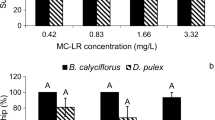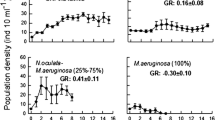Abstract
Cyanobacterial blooms consisting of Microcystis spp., collected from 14 water-bodies in Central India, and an adapted culture, were studied for likely impact on zooplankton community. When fed with single cells of Microcystis from several locations, in mixtures with Chlorella, population growth of the cladoceran Moina macrocopa was suppressed. Microcystis alone was unsuitable as food. In three cases, bloom extracts enhanced mortality of starved zooplankton. Extracts from several sources inhibited protease activity when trypsin or a crude extract from zooplankton served as enzyme source. Upon fractionation by solid-phase extraction, the C-18 passed extract contained the anti-protease and toxic substances for zooplankton, whereas a methanol eluted fraction retained the trypsin inhibitory substance. The study suggests that production of protease inhibitors by cyanobacteria is a factor responsible for feeding inhibition and mortality in zooplankton, which in turn could regulate the community structure of grazers.
Similar content being viewed by others
References>
Aspain, A., M. Hall & K. Soderhall, 1990. The effect of endogenous proteinase inhibitors on the prophenoloxidase activating enzyme, a serine proteinase from crayfish haemocytes. Insect Biochem. 20: 707–718.
Carmichael, W.W., 1997. The cyanotoxins. Adv. Bot. Res. 27: 211–256.
Christoffersen, K., 1996 a. Effect of microcystin on growth of single species and on mixed natural populations of heterotrophic nanoflagellates. Natural Toxins 4: 215–220.
Christoffersen, K., 1996 b. Ecological implications of cyanobacterial toxins in aquatic food webs. Phycologia 35: 42–50.
Codd, G. A., C. J. Ward, K. A. Beattie & S. G. Bell, 1999.Widening perceptions of the occurrence and significance of cyanobacterial toxins. In Peschek, G. A., W. Loffelhardt & G. Schmetterer (eds), The Phototrophic Prokaryotes. Kluwer Academic/ Plenum Publishers, New York: 623–632.
DeBernardi, R. & G. Giussani, 1990. Are blue-green algae a suitable food for zooplankton? An overview. Hydrobiologia 200/201: 29–41
DeMott, W. R., Q. X. Zhang & W. W. Carmichael, 1991. Effects of toxic cyanobacteria and purified toxins on the survival and feeding of a copepod and three species of Daphnia. Limnol. Oceanogr. 36: 1346–1357.
Gilbert, J. J., 1990. Differential effects of Anabaena affinis on cladocerans and rotifers: mechanisms and implications. Ecology 71: 1727–1740.
Gulati, R. D., 1990. Structural and grazing responses of zooplankton community to biomanipulation of some Dutch water bodies. Hydrobiologia 200/201: 99–118.
Imada, C., M. Maeda & N. Taga, 1985. Purification and characterization of the protease inhibitor 'monastatin' from a marine Alteromonas sp. with reference to inhibition of the protease produced by a bacterium pathogenic to fish. Can. J. Microbiol. 31: 1089–1094.
Jakobi, C., K. L. Rinehart, R. Neuber, K. Mez & J. Weckesser, 1996. Cyanopeptolin SS, a disulphated depsipeptide from a water bloom in Leipzig (Germany): structure elucidation and biological activities. Phycologia 35: 111–116
Jungmann, D., 1992. Toxic compounds isolated from Microcystis PCC 7806 that are more active against Daphnia than two microcystins. Limnol. Oceanogr. 37: 1777–1783.
Jungmann, D. & J. Benndorf, 1994. Toxicity to Daphnia of a compound extracted from laboratory and natural Microcystis spp. and the role of microcystins. Freshwat. Biol. 32: 13–20.
Jungmann, D., M. Henning & F. Juttner, 1991. Are the same compounds in Microcystis responsible for toxicity to Daphnia and inhibition of its filtering rate? Int. Rev. ges. Hydrobiol. 76: 47–56.
Kirk, K. L. & J. J. Gilbert, 1992. Variation in herbivore response to chemical defenses: zooplankton foraging on toxic cyanobacteria. Ecology 73: 2208–2218.
Kurmayer, R. & F. Juttner, 1999. Strategies of the coexistence of zooplankton with the toxic cyanobacterium Planktothrix rubescens in Lake Zurich. J. Plankton Res. 21: 659–683.
Marwah, J. B., T. M. Shakila, N. S. Rao & S. N. Bagchi, 1995. Detoxification of a local Microcystis bloom by an algicidal metabolite from Oscillatoria late-virens. Indian J. exp. Biol. 33: 97–100.
Nandini, S. & T. R. Rao, 1998. Somatic and population growth in selected cladoceran and rotifer species offered the cyanobacterium Microcystis aeruginosa as food. Aqua. Ecol. 31: 283–298
Neurath, H., 1984. Evolution of proteolytic enzymes. Science 224: 350–357.
Nizan, S., C. Dimentman & M. Shilo, 1986. Acute toxic effects of the cyanobacterium Microcystis aeruginosa on Daphnia magna. Limnol. Oceanogr. 31: 497–502.
Raymont, J. E. G., 1983. Plankton and Productivity in the Oceans, 2. Pergamon Press, Oxford: 824 pp.
Shirai, M., K. Matsumuru, A. Ohtake, Y. Takamura, T. Aida & M. Nakano, 1990. Development of a solid medium for growth and isolation of axenic Microcystis strains (cyanobacteria). Appl. envir. Microbiol. 55: 2569–2571.
Watanabe, Y., M. F. Watanabe & M. Watanabe, 1986. The distribution and relative abundance of bloom forming Microcystis species in several eutrophic waters. Jap. J. Limnol. 47: 87–93.
Weckesser, J., C. Martin & C. Jakobi, 1996. Cyanopeptolins, depsipeptides from cyanobacteria. Sys. appl. Microbiol. 19: 133–138.
Author information
Authors and Affiliations
Rights and permissions
About this article
Cite this article
Agrawal, M.K., Bagchi, D. & Bagchi, S.N. Acute inhibition of protease and suppression of growth in zooplankter, Moina macrocopa, by Microcystis blooms collected in Central India. Hydrobiologia 464, 37–44 (2001). https://doi.org/10.1023/A:1013946514556
Issue Date:
DOI: https://doi.org/10.1023/A:1013946514556




